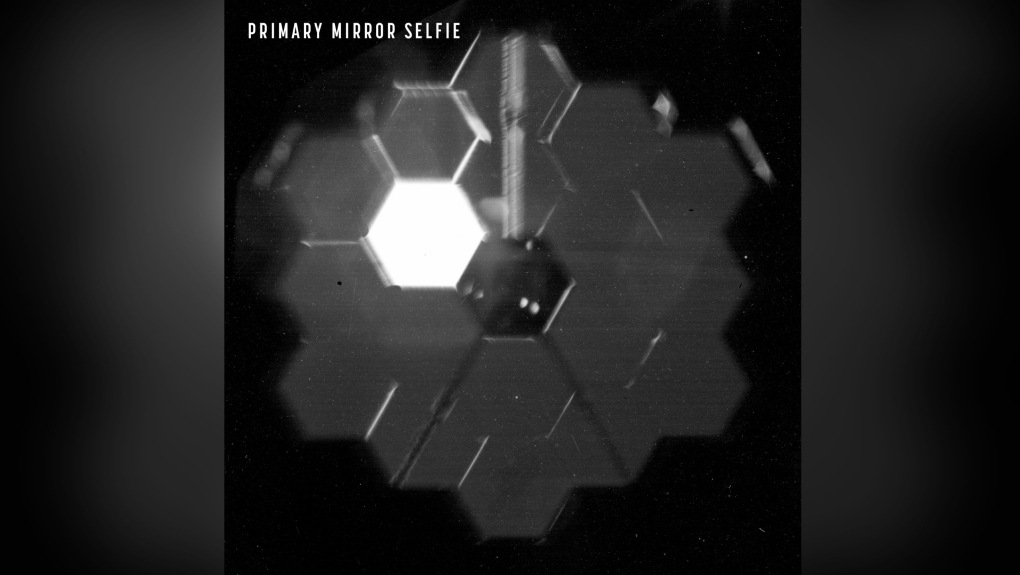The James Webb Space Telescope is setting up shop while it chills out a million miles from Earth.
The observatory shared its first selfie from space after testing its iconic gold mirror and Near Infrared Camera.
Webb has been in the process of cooling down and aligning its mirror segments since February 2, after reaching its orbital point beyond the moon on January 24. The telescope launched to space on December 25 and will serve as NASA's most complex and powerful observatory yet.
If the images look a little blurry, that's to be expected, Webb team members said. Right now, the telescope is still in the commissioning phase before it begins collecting data and science observations this summer, when dazzling new images of our universe are expected to be released.
CAPTURING STARLIGHT
Webb's latest challenge was a trial run of the Near Infrared Camera, or NIRCam, identifying dots of starlight from the same star in each of the 18 hexagonal segments of its massive mirror. The telescope aimed its mirrors at a bright solitary star in the Ursa Major constellation called HD 84406.
"This star was chosen specifically because it is easily identifiable and not crowded by other stars of similar brightness, which helps to reduce background confusion," according to the Webb team.
Webb created a mosaic of 18 points of starlight when mirror segments reflected this light back at the telescope's small secondary mirrors and into NIRCam's detectors.
Images like the ones NASA shared on Friday can help the Webb team make sure the mirrors are perfectly aligned before the observatory sets its sights on exoplanets and distant galaxies, forever changing the way we see the universe.
Over the next month, careful adjustments will unite the mirror segments so those 18 dots become an image of a single star.
"The entire Webb team is ecstatic at how well the first steps of taking images and aligning the telescope are proceeding. We were so happy to see that light makes its way into NIRCam," said Marcia Rieke, principal investigator for the NIRCam instrument and regents professor of astronomy at University of Arizona, in a statement.
The mosaic of 18 dots is the result of Webb capturing 1,560 images over the course of 25 hours, although the observatory was able to find the star during the first six hours and using just 16 images. The 18 points are just the center of a giant mosaic with more than 2 billion pixels.
"This initial search covered an area about the size of the full Moon because the segment dots could potentially have been that spread out on the sky," said Marshall Perrin, deputy telescope scientist for Webb and astronomer at the Space Telescope Science Institute in Baltimore, in a statement.
The mirror selfie was captured by a special lens inside NIRCam that can image the primary mirror rather than what Webb sees in space. The lens mainly exists for engineering and alignment, so it was a bonus image that made the Webb team say "holy cow," said Lee Feinberg, Webb optical telescope element manager at NASA's Goddard Space Flight Center in Greenbelt, Maryland.
KEEPING A DEEP FREEZE TO OPERATE
Webb's orbit will keep the telescope in line with Earth as our planet orbits the sun. This alignment protects the telescope from the heat released by the sun, Earth and even the moon.
It's imperative that the telescope stay cool because it will observe the universe in infrared light and detect the faintest signals from objects in our distant universe. Because infrared light can be detected as heat, the entire spacecraft needs to be shielded from bright sources of heat.
The spacecraft includes a five-layer sunshield to protect Webb's giant mirror and instruments from the sun's blistering rays. Webb's equipment needs to be kept at a very frigid negative 370 degrees Fahrenheit (negative 223 degrees Celsius) to operate.
Some of Webb's instruments need to be even colder to operate, so they will continue to cool down over the next few months. Future images captured by Webb will only become clearer and more detailed as the spacecraft cools and the mirrors align.
"This amazing telescope has not only spread its wings, but it has now opened its eyes," Feinberg said.








































